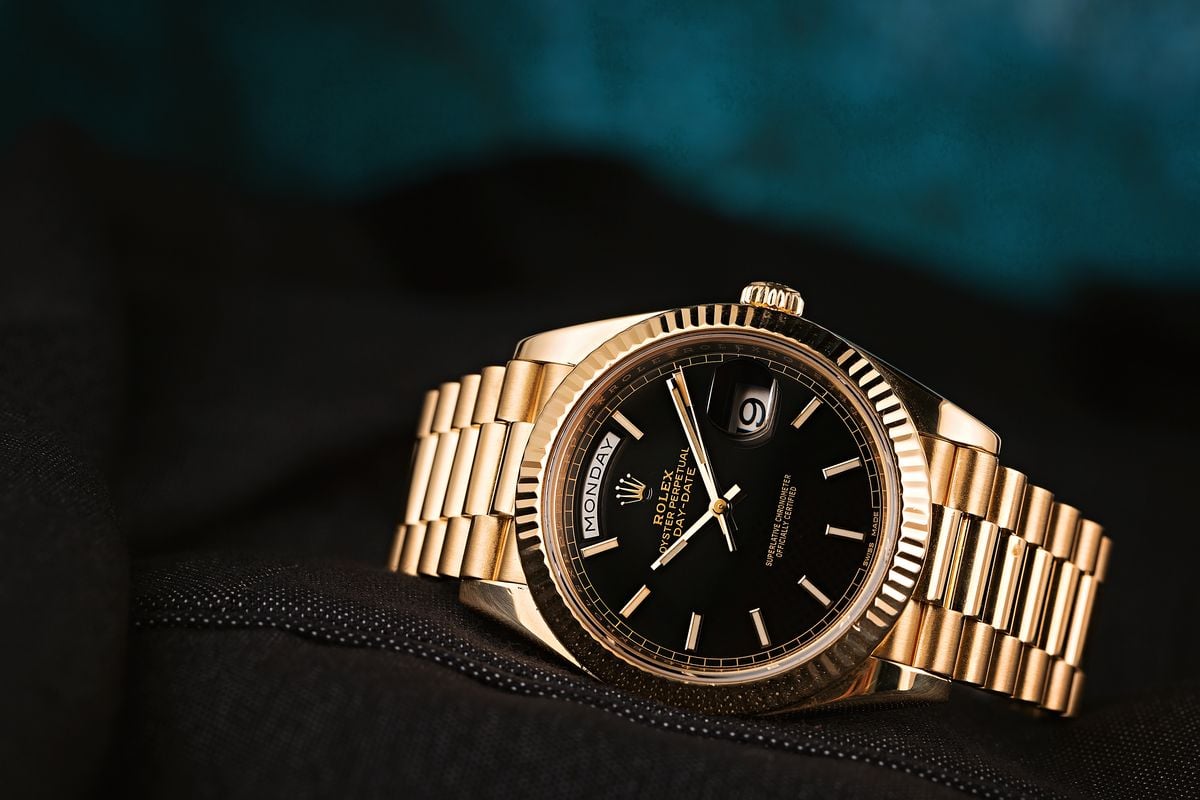Today, every single watch in Rolex’s catalog features an automatic self-winding mechanical movement. This means that the watch is not powered by a battery; in fact, no electricity is involved in any aspect of the watch's operation. Instead, it relies on an entirely mechanical movement that stores tension in a coiled spring, which unwinds and powers the watch. Additionally, unlike traditional manual-wind mechanical movements, the self-winding Perpetual movements in Rolex watches winds itself throughout the course of the day with the natural motion of the wearer's arm.
With that in mind, any automatic watch needs to be worn and receive motion in order for it to be able to wind itself. Should you not wear your automatic winding for a day or more, depending on the model, your watch may not be running when you go to pick it up next. Just because most Rolex watches are self-winding, that does not mean that they cannot also be manually wound, so in this article we are going to take a look at how to wind your Rolex watch.

One of the biggest drawbacks to automatic watches is that they will stop if they do not receive enough wear each day. Power reserves can differ from one movement to the next, with some modern calibers able to achieve multiple days of autonomy. However the vast majority of the traditional mechanical movements you are likely to encounter (including all Rolex models) have power reserves that range between 48 and 72 hours.
For an individual who only wears their watch during the work week, a watch with a 48-hour power reserve will not still be running by Monday morning after it gets taken off on Friday evening, and so it will need to be restarted and reset at the beginning of each week. For that reason, many mechanical watch owners like to keep their watches running (assuming that the watches are worn daily) as a means to eliminate the inconvenience of resetting them on Monday morning.
Other than wearing the watch during the weekend, there really are only two ways to ensure that a watch with a standard 48-hour power reserve will still be running by Monday morning. The first option is to use an automatic watch winder. These small watch boxes use electric motors to periodically rotate the watch and ensure it receives a sufficient amount of motion throughout the day. However, for all those that do not want the additional hastile of using a winder, the only way to keep the watch running through the weekend would be to manually wind it at some point.

In the past, certain Rolex watches were powered by traditional hand-wind movements, and some models even featured battery-powered quartz movements. However, today every single watch in Rolex's catalog has a self-winding movement, which uses Rolex's patented Perpetual rotor system (more-or-less a centrally-mounted pendulum) to wind the watch throughout the day. Similarly, while some older Rolex models featured standard push/pull winding crowns, every single Rolex watch in the brand’s contemporary catalog features a screw-down crown - even the various models from the Cellini collection that do not advertise themselves as having Oyster cases.
In Rolex terminology (and only concerning modern watches, as you will find some very old vintage Rolex models that were branded as having Oyster cases despite not having screw-down crowns), the word "Oyster" means that the case-back and winding crown screw down for water-resistance. Meanwhile, the word "Perpetual" means that the watch features a movement that is of the automatic/self-winding variety, enabling it to wind itself with the natural motion of the wearer’s arm.
Consequently, anytime you see a Rolex watch with the words Oyster Perpetual on the dial, there is a pretty good chance that you are dealing with an automatic watch with a screw-down crown and case-back. If your watch is a Rolex Oyster Perpetual model, then read on for the complete instructions for how to wind your Rolex.

Most people are familiar with winding traditional pocket watches; however due to Rolex’s Oyster Case and self-winding Perpetual movements, there are a couple steps that are different when winding a Rolex, compared to the process of winding a traditional pocket watch.
The instructions below are for how to wind a Rolex Oyster Perpetual watch. This means that the watch in question is of the self-winding variety, and that it features a screw-down crown. Should your watch either have a non-screw-down crown or a hand-wind-only movement, then be sure to read the additional sections below these instructions for additional details that pertain to the winding process for your specific Rolex watch.
The first thing you will need to do before you can wind your watch (or set the time or date) is to unscrew the winding crown from the side of the case.
To do this, simply grip the crown and rotate it towards you, turning it towards the 6 o'clock direction (counter-clockwise). Keep rotating the crown until it is entirely free from the threads and pops out to its natural position. The important part here is to not pull out the crown at all like you would to set the time, it should be in its natural position, still all the way inward, just free from the threads that secure it to the side of the case.
When the crown is in this position and ready for manual winding, the watch will stay running (assuming that it was running before). Additionally, rotating the crown in either direction will not adjust the time nor the date (or any other features, if applicable).
From here, start rotating the winding crown away from you and towards the 12 o'clock location (clockwise). Rotating the crown in the opposite direction will not "unwind" your watch, but only clockwise motion will supply tension to the mainspring and wind your watch; rotating it in the other direction does absolutely nothing.
Additionally, should you notice that the watch stops running or that the date or time changes when you turn the crown, this means that you are not in the proper position for manual winding, and that the crown accidentally got pulled out to one of its other positions when it was unscrewed. If this is the case, lightly press the crown inward towards the watch, and it should return to its proper winding position.
Keep turning the winding crown until you hit approximately 40 rotations. At this point, the watch will be fully wound; however you will still be able to turn the winding crown just as you did before. With that in mind, there is no worry about accidentally "overwinding" your watch during manual winding - provided that it has an automatic movement.
As long as your watch is one of Rolex's Perpetual models with a self-winding movement, there is no way that you can "overwind" it. Once the mainspring is fully wound, a type of slip gear engages that prevents additional tension from being supplied to the mainspring. This mechanism exists as a safeguard to prevent watches from automatically overwinding themselves; however it also ensures that you do not inadvertently damage your watch should you choose to hand-wind it.
You can continue to rotate the winding crown all day long, and other than putting a tiny amount of additional wear and tear on the watch's winding components, you run zero risk of actually breaking your watch. However, if you watch has a manual-wind only movement, make sure you read the additional sections below to ensure that you do not accidentally damage it during the winding process.
At this point, your watch should now be running again, even if it was stopped when you first started the winding process. If the seconds hand remains stopped, give it a gentle shake, and that should allow the movement to overcome its moment of inertia and start right up again.
With the watch fully wound, go ahead and pull out the crown to set the time and date (if necessary). Setting instructions can differ greatly from one Rolex watch to the next, depending on the type of movement it has and the additional features or complications that it may offer, so be sure to reference the correct setting instructions for your specific watch and movement.
The last step of how to wind your Rolex is to screw the crown back down to the side of the case. Rolex's legendary Oyster Case does an absolutely amazing job of keeping the movement protected from moisture and dust. However, its ability to do so is contingent on its case-back and winding crown being fully screwed down and secured to the case.
To screw your winding crown back down, simply press it inwards, and while you are still applying inward pressure, start rotating it away from you and towards the 12 o'clock location (clockwise). You will feel the threads engage each other, and the crown will start to screw downwards to the case.
Keep turning the winding crown until it is fully screwed down to the side of the case. While it is important to ensure that the crown is screwed down all the way, applying excessive pressure runs the risk of damaging the threads on both the winding crown and the case tube that secures it.
Once your watch is fully wound and the crown is screwed all the way back down to the side of the case, the winding process is complete, and you are free to strap your watch back on and start wearing it again!

Although all modern Rolex watches have screw-down crowns, you will encounter certain models - particular vintage and dress watches - that do not include this feature. Should your Rolex watch not have a screw-down crown, the winding instructions are even more simple, as you do not first need to unscrew the winding crown before you can access the movement.
For older vintage Rolex watches that do not feature screw-down crowns, the winding process is near-identical to the process involved with winding an old pocket watch. Looking down at the watch, simply rotate the winding crown away from you and towards the 12 o'clock location (clockwise). Just like with an traditional pocket watch, there is no need to pull out the crown and stem at all - that is only necessary to set the time or date - leave it pressed all the way into the case and just give it a turn.
When winding your Rolex, it is important to know whether it has an automatic or manual winding movement. The How to Wind a Rolex instructions above are for models with self-winding Perpetual movements, but not all Rolex watches with screw-down crowns have self-winding movements, so if your models has a traditional hand-wind movement it is important to reference the additional notes in the section below.
Many Rolex watches without screw-down crowns also do not have automatic self-winding movements. Often these models are elegant dress watches that omit the Oyster cases and Perpetual movements of their siblings for more elegant and refined designs.
However, there are also a number of Rolex watches that have screw-down Oyster cases, but they are fitted with traditional hand-wind movements and do not have the ability to wind themselves. On these models, the process of unscrewing the winding crown is exactly the same; however the key difference comes into play once the watch is fully wound.
While you will never reach a natural stopping point while manually winding an automatic watch, this is not true for those with manual-wind-only movements. Just like with an old pocket watch, once the mainspring is fully wound, the winding crown will stop rotating. Forcing it beyond this point will almost certainly damage the watch, as these manual-wind only movements do not feature the same slip gear as automatic watches.
For these Rolex watches with hand-wind movements and screw-down crowns, once the winding crown stops rotating, your watch is fully wound. Simply press it back inward and screw it down to the case to ensure your watch's water-resistance, and you are free to strap it back onto your wrist.

It is important to remember that as long as you wear your Rolex every day and it receives a sufficient amount of motion, you will not need to manually wind your watch. Many Rolex owners are not even aware that their watches can be wound by hand, as it is something that they have never needed to do before. However, even if you do not ever need to manually wind your Rolex, that does not mean that it cannot be manually wound, and knowing how to wind your Rolex watch is an important part of the ownership process.
That being said, if you do not need to wind your Rolex, there really is no reason to do so - especially not on a regular basis. In fact, daily hand-winding of a watch that already has a fully-wound mainspring is not ideal as far as the longevity of the mechanics. Manually winding a watch that is already fully wound does absolutely nothing to top-off its power reserve, while only putting a tiny amount of additional wear and tear and the movement's winding components.
Keeping that in mind, manually winding your Rolex will not damage it, so feel free to wind by hand if necessary if you want your watch to stay running for multiple days at a time without being worn on your wrist. Remember, at one point, all watches were hand-wind only, so these movements were designed to be wound by hand - even if it has become just a secondary method of winding on modern automatic mechanical movements.
Furthermore, unnecessary screwing and unscrewing of the winding crown can put additional wear and tear on the internal rubber gaskets that are responsible for keeping moisture out of the case. Even the most water-resistant watch on the planet will let in water if it has a bad gasket, so preserving these seals is another important aspect of ownership should you plan on wearing your Rolex watch in the water.
Rolex anticipates that owners will need to periodically unscrew the crowns of their watches in order to wind them or set the time and date, so there is no need to shy away from using your winding crown for its intended purpose. However it is just something to keep in mind if you find yourself unscrewing your crown on a daily basis.
Lastly, it is important to note that you should not feel a lot of mechanical resistance while manually winding your watch. You may feel tension start to build as the mainspring gets wound; however it should still rotate smoothly and freely. If it feels sticky, crunchy, or you otherwise feel a significant amount of resistance coming from within the movement, do not under any circumstances force it. Mechanical watch movements are made of dozens of tiny, precisely made components, and it does not take much force to damage the delicate teeth of a gear.
Winding your Rolex watch is a natural part of ownership, but it is important that you do it properly. If something ever doesn’t feel right and you have to put a noticeable force behind it, stop what you are doing and bring your watch to your nearest Rolex Authorized Service Provider. Forcing anything in the movement can often lead to damage and expensive internal repairs, and double checking things with a professional will save you a huge headache in the long-run.
